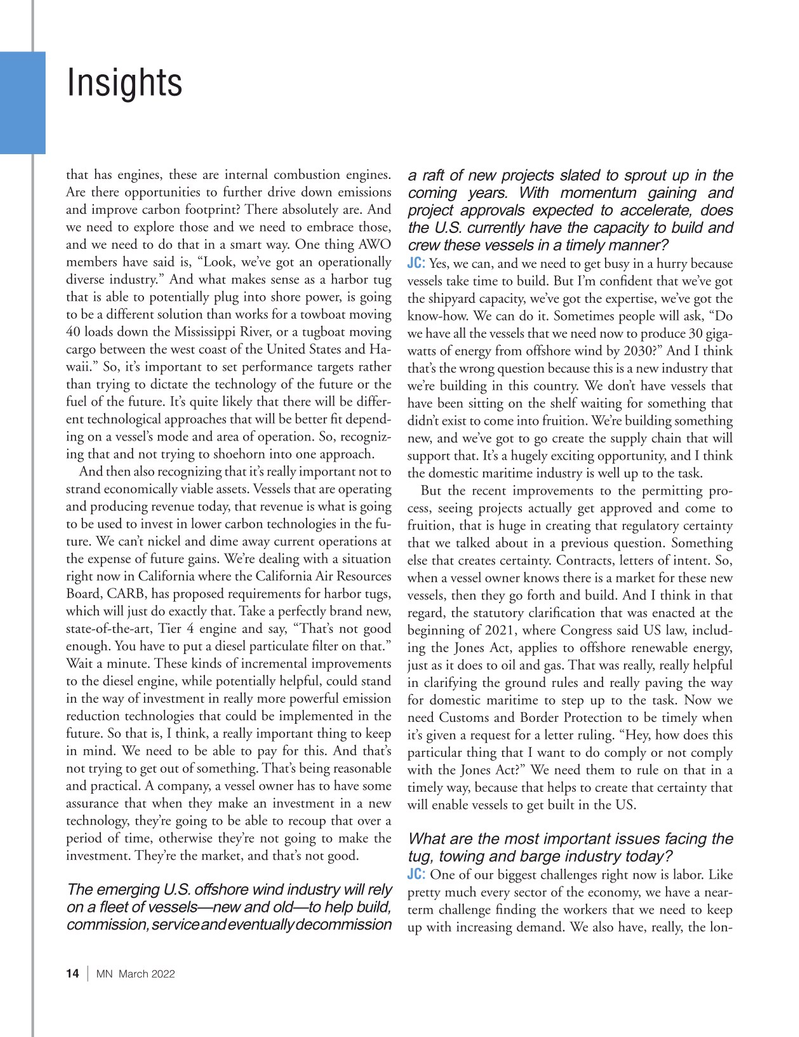
Page 14: of Marine News Magazine (March 2022)
Pushboats, Tugs & Barges
Read this page in Pdf, Flash or Html5 edition of March 2022 Marine News Magazine
Insights that has engines, these are internal combustion engines. a raft of new projects slated to sprout up in the
Are there opportunities to further drive down emissions coming years. With momentum gaining and and improve carbon footprint? There absolutely are. And project approvals expected to accelerate, does we need to explore those and we need to embrace those, the U.S. currently have the capacity to build and and we need to do that in a smart way. One thing AWO crew these vessels in a timely manner?
members have said is, “Look, we’ve got an operationally JC: Yes, we can, and we need to get busy in a hurry because diverse industry.” And what makes sense as a harbor tug vessels take time to build. But I’m con? dent that we’ve got that is able to potentially plug into shore power, is going the shipyard capacity, we’ve got the expertise, we’ve got the to be a different solution than works for a towboat moving know-how. We can do it. Sometimes people will ask, “Do 40 loads down the Mississippi River, or a tugboat moving we have all the vessels that we need now to produce 30 giga- cargo between the west coast of the United States and Ha- watts of energy from offshore wind by 2030?” And I think waii.” So, it’s important to set performance targets rather that’s the wrong question because this is a new industry that than trying to dictate the technology of the future or the we’re building in this country. We don’t have vessels that fuel of the future. It’s quite likely that there will be differ- have been sitting on the shelf waiting for something that ent technological approaches that will be better ? t depend- didn’t exist to come into fruition. We’re building something ing on a vessel’s mode and area of operation. So, recogniz- new, and we’ve got to go create the supply chain that will ing that and not trying to shoehorn into one approach.
support that. It’s a hugely exciting opportunity, and I think
And then also recognizing that it’s really important not to the domestic maritime industry is well up to the task.
strand economically viable assets. Vessels that are operating
But the recent improvements to the permitting pro- and producing revenue today, that revenue is what is going cess, seeing projects actually get approved and come to to be used to invest in lower carbon technologies in the fu- fruition, that is huge in creating that regulatory certainty ture. We can’t nickel and dime away current operations at that we talked about in a previous question. Something the expense of future gains. We’re dealing with a situation else that creates certainty. Contracts, letters of intent. So, right now in California where the California Air Resources when a vessel owner knows there is a market for these new
Board, CARB, has proposed requirements for harbor tugs, vessels, then they go forth and build. And I think in that which will just do exactly that. Take a perfectly brand new, regard, the statutory clari? cation that was enacted at the state-of-the-art, Tier 4 engine and say, “That’s not good beginning of 2021, where Congress said US law, includ- enough. You have to put a diesel particulate ? lter on that.” ing the Jones Act, applies to offshore renewable energy,
Wait a minute. These kinds of incremental improvements just as it does to oil and gas. That was really, really helpful to the diesel engine, while potentially helpful, could stand in clarifying the ground rules and really paving the way in the way of investment in really more powerful emission for domestic maritime to step up to the task. Now we reduction technologies that could be implemented in the need Customs and Border Protection to be timely when future. So that is, I think, a really important thing to keep it’s given a request for a letter ruling. “Hey, how does this in mind. We need to be able to pay for this. And that’s particular thing that I want to do comply or not comply not trying to get out of something. That’s being reasonable with the Jones Act?” We need them to rule on that in a and practical. A company, a vessel owner has to have some timely way, because that helps to create that certainty that assurance that when they make an investment in a new will enable vessels to get built in the US.
technology, they’re going to be able to recoup that over a period of time, otherwise they’re not going to make the
What are the most important issues facing the investment. They’re the market, and that’s not good.
tug, towing and barge industry today?
JC: One of our biggest challenges right now is labor. Like
The emerging U.S. offshore wind industry will rely pretty much every sector of the economy, we have a near- on a ? eet of vessels—new and old—to help build, term challenge ? nding the workers that we need to keep commission, service and eventually decommission up with increasing demand. We also have, really, the lon- 14 | MN March 2022

 13
13

 15
15
